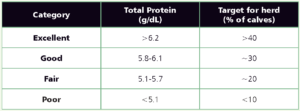Written by Jenny Bellini and Hannah Fitzsimmonds, vets at LLM Farm Vets
Calf health and management has changed dramatically over the last 10 years, with the benefits of optimising calf performance well known as being vital to the future productivity and profitability of the herd. The increased investment in calves both in resources and time, makes it even more frustrating when things go wrong. Calves are highly sensitive to change and inconsistency, and performance can easily be derailed!
Automatic Feeders – With increasing use of auto calf feeders and ad lib feeding (e.g. 40 FIT programmes), as with any robotic technology, they are only as good as what goes in. Ensuring the milk replacer being fed is suitable for high levels of feeding is important. Also checking settings of machines, whether old or new, as it is often found calves are not getting what you may think, e.g. is milk too dilute, 1L of water is added on to powder rather than being made up to 1L. Therefore, regularly reviewing the settings, alongside cleanliness and maintenance of any automatic calf feeders is of high importance. Optimising health is only possible when calves are fed well.
Vaccine Protocols – Vaccines are often key to success on many units, both in the dry cows to boost passive transfer success and in young calves to prevent pneumonia. Whether using in cows or calves, ensuring vaccines are stored and given correctly is key. A recent study (MSD, 2020) found 89% of fridges on farms were outside of 2-8°C temperature range for vaccine storage some of the time, with the maximum temperature reached being 12°C and the minimum -11.5°C. Most vaccines should be used up within hours of opening the bottle and should not be broached multiple times. Using clean needles and syringes and ensuring correct timings and administration of vaccination will also lend to better success of the vaccines.
Hygiene and Calf Environment – Cleaning and disinfection regimes in calf sheds are often thorough, though it’s always good to review! This can include making sure any disinfectants used have the right amount of contact time, or ability to properly isolate any sick calves. Also consider how the calf is transported to the calf shed. The wheelbarrow, loader bucket etc, can easily be forgotten and not as clean as it should be but they can be the first place the calves’ open navel comes in to contact. When assessing the calf environment, get in the shed at calf level, sheds can often feel airy and fresh in the feeding passage but very different at the back of pens!
Data Recording – Recording sufficient data is easily slipped from the mind, especially when things get busy. However, collecting information has two uses. Firstly, it is becoming increasingly asked for by processors, but secondly your vets can use this data to form part of your health plan. More importantly they can use the data to react to a drop in performance, identify patterns of disease and identify areas of calf management that are proving a challenge. Useful data includes any mortality, age of this and suspected cause, any illness and additionally treatments administered and response to this. Recording growth rates is also an important piece of data to help identify ways to increase feed efficiency and health in youngstock; the industry is often told to aim for >0.8kg DLWG but if this is not measured, benchmarking and improvements are harder to do.
Re-thinking Colostrum Success – Blood sampling calves 24 hours – 7 days old has become common practice to assess total protein level in the blood, which gives us an indication of the success of passive transfer. The aim is for as many antibodies (IgGs) from the dam to pass via the colostrum into the blood stream of the calf and provide immunity for the first weeks of life until the calf has developed its own immune system. Recent research out of Cornell suggests we should rethink our targets. Typically, over 5.5g/dL on a blood sample is regarded as good passive transfer and >85% of calves achieving this is regarded as a herd level success. Are there benefits to be had for calf health and mortality for aiming higher? The data below suggests the answer is yes!
Calves were categorised according to passive transfer status, as in the table below:

They found that:
1. Calves in the fair category were 5% more likely to die.
2. Calves in the poor category were 10% more likely to die.
3. Calves in the excellent category were less likely to develop disease, these effects were seen
through to 60 days.
With pressure mounting to maximise profitability and sustainability on farm, as well as external pressure from processors and the wider industry to reduce antibiotic use, prevention of disease is becoming more important all the time. As stated at the start, ensuring good calf health increases both productivity and profitability, but also morale! Working closely with your vet and nutritionist this can be achieved and sustained.
For more information or advice on maximising your youngstock performance, get in touch with your local NWF Sales Specialist, call 0800 756 2787 or get in touch with our youngstock specialists HERE.
